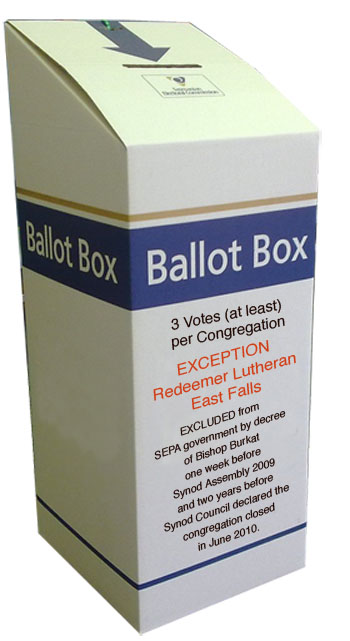Seeking Transparency in Church Leadership
 This is an election year. We as a nation will elect a president—a decision we must all live with for four years.
This is an election year. We as a nation will elect a president—a decision we must all live with for four years.
It is also an election year in the Southeastern Pennsylvania Synod (SEPA) Synod of the ELCA. SEPA will elect a bishop for a six-year term and congregations will live with that choice for more than half a decade.
We will take less time preparing for this choice.
The Church has a history of cloistering leaders. Clergy may know one another. Most lay leaders have little knowledge of the names presented to them on the floor of Synod Assembly.
People, today, want to know who their leaders are and what they stand for. We want to know this every day, not just at election time. There was a time when this was difficult. Communication was expensive and unwieldy. This is no longer an excuse. Church leadership can and should interact with church members on a daily basis. This should be a joy not a drudge.
There are long traditions of leadership by intimidation and fear in the Church. It didn’t start out that way, but it goes back centuries. The Reformation tried to address this but even today this leadership style rears its head in defiance of the Christ’s message of love.
In the business world, people have a choice. They can work for a company or they can leave.
It’s a bit different in the Church. People want to stick with their faith and their congregational community. It’s all wrapped up in their relationship with God, their understanding of who they are, and their personal and family faith journeys. When dissatisfied, they aren’t likely to look for a new Church as a first option.
In other words, they care.
That’s a good thing—a treasure!
As SEPA Synod prepares for its 2012 Annual Assembly, the topic is worth consideration.
SEPA Synod delegates need to carefully examine the relationship between synod leadership and the congregations—the only reason synods exist.
The relationship between the synod and its impressive list of rostered leaders is more difficult to analyze but just as important. Each question asked below might also be asked by each rostered professional leader.
Perhaps its best to start by examining the relationships between congregations, their elected leaders and synod leadership.
- Do you know one another? Are you working together — interdependently — as the operating constitutions require? What do you know about the names on the ballot? What do they stand for? What do they know about you?
- What do your leaders believe?
- Do your members have a voice? Under Lutheran polity, you are supposed to! It’s a precious Lutheran concept that clergy and laity have equal leadership standing.
- Do your elected leaders listen to the people they are serving? Is there two-way communication?
- Is there a plan for reversing strong downward trends—or will that be presented after a six-year decision is made?
- Are your lay members comfortable with synod leadership? Must all communication go through your pastor? Are your phone calls returned? Are dates for meetings mutually agreed upon? Are they scheduled within a month of request?
- Is there trust?
- What is the synod’s vision for moving forward? Is every congregation included in the vision?
- Does SEPA treat every congregation and its leaders with respect and dignity — as valued members of God’s kingdom? Are elected congregational leaders treated with respect?
- Is your only interaction with synod when there is a leadership change? When was the last time a bishop visited your congregation just to listen and get to know you?
- Do you know what your leaders are doing in your name and in the name of God?
The choice of bishop is pivotal to the image of our Church. Let’s do this carefully.
